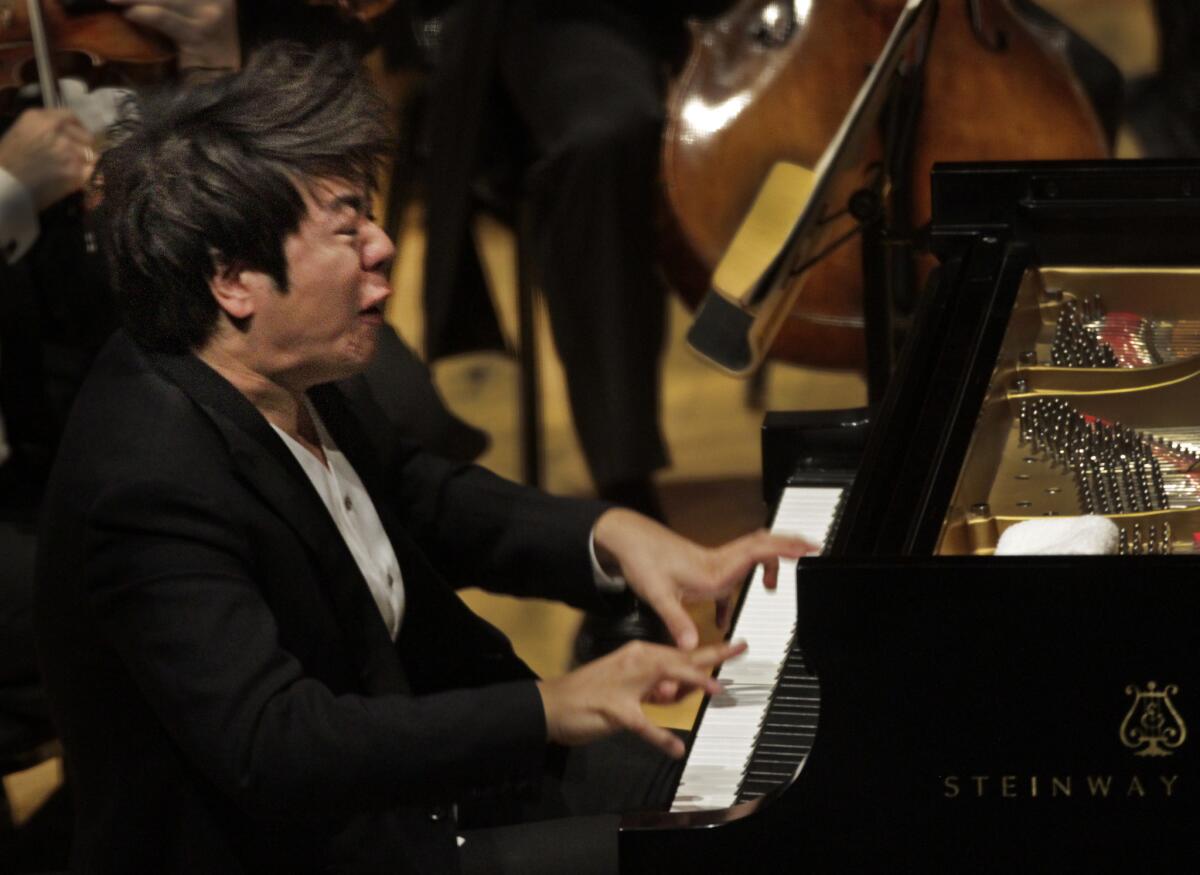Review: Lang Lang is brilliant but bored in concert with L.A. Philharmonic

Lang Lang has always shown a respectful attitude toward past masters. In the notes for a new recording of piano concertos by Bartòk and Prokofiev, he mentions admiring the soulfully eloquent Hungarian soloist, Géza Anda, a pianist Lang Lang resembles not at all.
But for a performance of Prokofiev’s Piano Concerto No. 3 with Gustavo Dudamel and the Los Angeles Philharmonic Thursday night in Walt Disney Concert Hall, Lang Lang appeared to choose two even more unlikely figures to emulate.
His latest hairstyle looks like an update of Edd “Kookie” Byrnes’ ducktail, which is no big deal. But if the Kookie hipster narcissism goes much further that could be a problem.
His technique looked like a spectacular acrobatic embellishment of Chico’s exaggerated finger work in Marx Brothers movies. That, too, may wind up a big deal. A physician in the audience quipped at intermission that he hopes the Chinese superstar has a good pension plan. Hands cannot sustain that kind of playing for long.
Lang Lang has been playing Prokofiev’s virtuosic concerto for half his life — since he was 16. He opened the L.A. Phil’s Hollywood Bowl season three years ago with it. The Third is also on the new Lang Lang Bartòk and Prokofiev recordings, here with Simon Rattle and the Berlin Philharmonic.
He plays it with exceptional fluidity. At the Bowl there was a relative lack of funny business, perhaps because it was his first time working with Dudamel. Nor does Lang Lang go overboard on the recording either, fitting in almost conventionally with the plush cushion of sound created for him by Rattle and the Berliners.
Thursday, though, he played as though he were bored with the whole thing. He tossed off fast runs like they were less than nothing. He threw accents around just to show he could, often exaggerating his hands in the Chico manner, not that Chico or anyone else has ever displayed quite the same skill or flair.
Lang Lang is an exceptional talent; no other pianist of his generation has his gifts. I’ve long believed it worth accepting his excessive showboating, hard as that sometimes is to endure, for the sake of genuine greatness. For his last appearance in Disney with Dudamel and the L.A. Phil, he played Tchaikovsky’s First Piano Concerto as though it were jazz. The performance was wild and occasionally obnoxious, but it was also unique and unforgettable.
In the Prokofiev, Lang Lang wasn’t beyond wondrous brilliance or elegance. Some of the slow passages were gorgeously dreamy. No one doubts his phenomenal technique. But this time he didn’t make his more egregious points sound spontaneous so much as the result of boredom, of a pianist who has gotten himself into a rut he doesn’t know how to get out of.
Dudamel could help. Not by indulging Lang Lang, as he does, but rather by example. The program opened and closed with waltz-based Ravel scores — a lovingly played “Valses Nobles et Sentimentales” and a brilliant “La Valse.” Dudamel also used this as an occasion to introduce an intriguing dance-based piece by Venezuelan composer Paul Desenne, who is resident composer of El Sistema.
In “La Valse,” Dudamel, as Lang Lang had, took liberties, some extreme in the conductor’s bringing out percussive effects and accents near the end. But they were for a powerful purpose.
“La Valse” is a notoriously undanceable waltz. Having served in the French army’s effort on the Western Front during World War I, Ravel had strong reason to unravel the Viennese waltz. No matter how far the composer pulls the waltz apart, Dudamel goes one step further. But the conductor never allows it to stop being a waltz. Not only was this one of the most extreme performances of it I have heard, but it was also the most danceable. The exaggerations were not egregious but part of a bigger, disturbing, riveting phenomenon.
Desenne’s “Sinfonia Burocràtica ed’Amazzònica” is also a kind of dissipated dance music. The composer — who divides his time between Cambridge, Mass., and Caracas — describes his five-movement, 15-minute chamber concerto as a clash of cultures in South America. He took his bow wearing yellow pants, blue shirt, red shoes and dark jacket.
Crickets and frogs in the night jungle, a slithering 12-tone snake and a shamanic healer are conjured up. The fourth movement’s motivation is the 1928 massacre of banana plantation workers described in Gabriel García Márquez’s “One Hundred Years of Solitude.” In the final movement, “Death of the Automobile,” the orchestra sputters like an old clunker.
The Venezuelan score contains a wealth of insinuating Latin dance styles, irresistible melodies and quirky instrumental effects. But what makes Desenne’s music haunting is the composer’s continual off-kilter turns of phrase. You think you know what to expect, the landscape is familiar, but there is always something a little spooky lurking around the corner.
I wish Desenne would write a concerto for Lang Lang, perhaps guiding the pianist back on the right unexpected track.
More to Read
The biggest entertainment stories
Get our big stories about Hollywood, film, television, music, arts, culture and more right in your inbox as soon as they publish.
You may occasionally receive promotional content from the Los Angeles Times.











